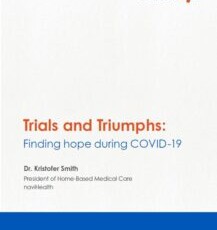As the novel coronavirus began to spread in March, fear of being hooked to a machine with the end of life looming quickly became a national storyline — particularly for seniors who did not have an end-of-life plan. As we reflect on National Hospice and Palliative Care month, it is clear just how important it is for seniors and their loved ones to set appropriate care goals before it’s too late.
Reinforce the need for end-of-life planning
When a senior who is living in a long-term care facility is diagnosed with COVID-19, the survival rate is grim. In fact, the toll among long-term care residents makes up 6% of the country’s COVID-19 cases and 39% of deaths, according to the Centers for Disease Control and Prevention (CDC). This has forced end-of-life discussions to happen in a very small window between seniors and family members, or worse, between seniors and emergency department clinicians. Unfortunately, the high volume of COVID-19 patients have made it nearly impossible for these seniors and clinicians to have “adequate time to clarify goals of care.”
Gina BrunoVP, Value-Based CarenaviHealth
“In any sort of emergent situation, it can be very difficult to reflect on goals and wishes and to make sure that our family members are part of decisions and that documents are in place,” said Gina Bruno, vice-president of value-based care at naviHealth. “But this has highlighted the need to have those conversations, have them early, and have them in a time of non-crisis to make sure that seniors have articulated what’s important to them about their ongoing care and any recovery needs they may have.”
The role of palliative care has been severely impacted during the pandemic due to “overburdened health systems, restrictions on face-to-face clinical interactions and sometimes rapid physiologic decline among patients with COVID-19.” However, the gap in care is substantial and is leading to heartbreaking stories of families losing loved ones before any type of care plan can be discussed.
Preparing to have end-of-life planning conversations with your loved ones is crucial, and palliative care workers understand its importance for families. Many providers are beginning to take creative, proactive steps to strengthen the palliative care response to future surges. For example, a hospital in Colorado identified three action pillars in preparation for a second surge:
Improve communication and documentation of patients’ goals of care and preferences for treatment prior to and during a COVID-19 surge.Ensure alternative care processes and spaces for patients receiving comfort-focused care to accommodate expected surge overflow from hospitals, nursing homes and other care facilities.Create a virtual hotline for round-the-clock, specialty-level advice and support to extend palliative care expertise during a surge.
It takes a village – and the village needs to be cared for, too
The epidemic of loneliness is also having a significant impact on the senior population in nursing homes across the country — residents have had limited to no access to family members for more than nine months. Sadly, due to national and local visitor restrictions, many healthcare professionals including hospice workers have found themselves becoming the link between loved ones saying one last virtual goodbye.
Healthcare professionals have been dealing with the death of their patients at such an alarming rate that experts have warned of the significant mental impact that COVID-19 has and will have on the industry.
“I think what we’ve seen through COVID-19 is the need to support professional caregivers in addition to the family caregivers,” said Bruno.
A study from China of 1,257 healthcare workers attending to COVID-19 patients in 34 hospitals found that 50% showed signs of depression, 45% reported anxiety and 72% had psychological distress. Stress has been an issue for healthcare workers long before the pandemic, with 60% of emergency physicians experiencing burnout in their career, according to the American College of Emergency Physicians.
Healthcare professionals are not only putting their overall health in jeopardy every day they go to work, but their families’ health as well. In fact, it may be their biggest concern throughout the pandemic.
For direct care workers such as nursing assistants, personal care aides and home health aides who work in residential care settings and private homes, many are forced to decide between the health of their family and their financial well-being.
LeadingAge recently released a study on the impact that increasing wages for direct care workers can have on the level of quality care, overall costs and staffing shortages. Raising pay to what MIT has identified as a “living wage” would reduce labor shortages by 330,000 full-time employees by 2022 and reduce the use of public programs by 16.8%, or $1.6 billion. According to the research, these increases would allow care recipients to experience better quality care, payors will see reduced costs for avoidable adverse events and employers will experience fewer vacancies and a lower turnover rate.
But above all else, the study shows that the pay increase will allow one in eight direct care workers to no longer live in poverty.
“Above all, COVID-19 has exposed just how interconnected we all are— patient, provider, caregiver— and the need to make sure that everyone in that village is healthy,” said Bruno.
The post Setting appropriate care goals and taking care of ‘the village’ appeared first on naviHealth.
Source: Navi




